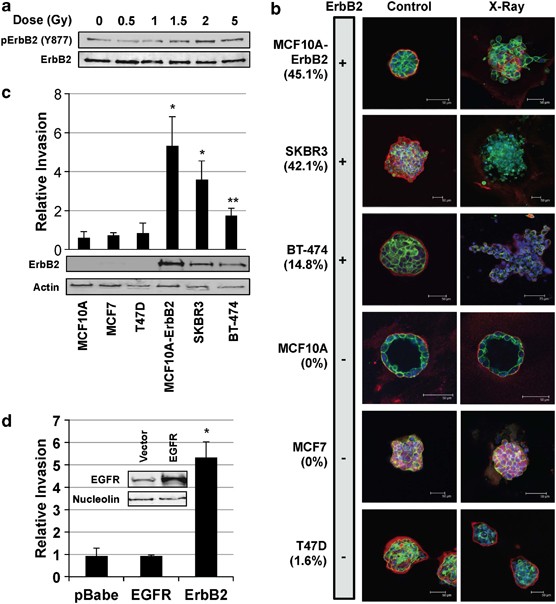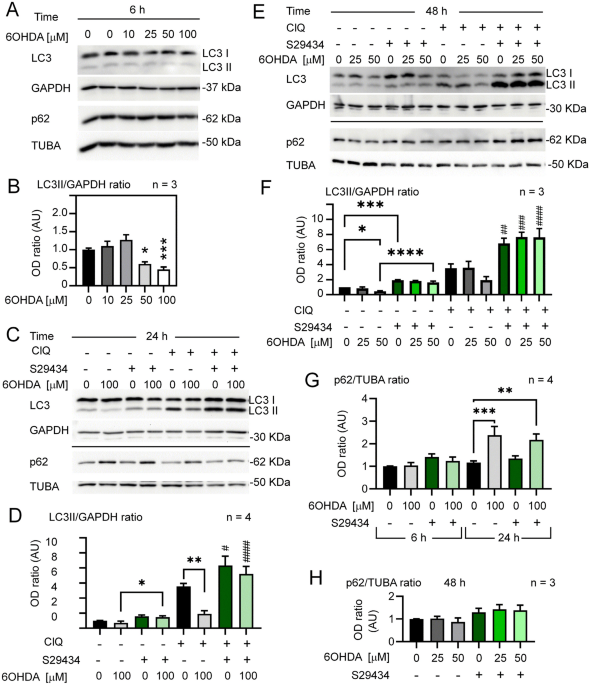
- Select a language for the TTS:
- UK English Female
- UK English Male
- US English Female
- US English Male
- Australian Female
- Australian Male
- Language selected: (auto detect) - EN
Play all audios:
ABSTRACT ErbB2 is frequently highly expressed in premalignant breast cancers, including ductal carcinoma _in situ_ (DCIS); however, little is known about the signals or pathways it
contributes to progression into the invasive/malignant state. Radiotherapy is often used to treat early premalignant lesions regardless of ErbB2 status. Here, we show that clinically
relevant doses of ionizing radiation (IR)-induce cellular invasion of ErbB2-expressing breast cancer cells, as well as MCF10A cells overexpressing ErbB2. ErbB2-negative breast cancer cells,
such as MCF7 and T47D, do not invade following treatment with IR nor do MCF10A cells overexpressing epidermal growth factor receptor. ErbB2 becomes phosphorylated at tyrosine 877 in a dose-
and time- dependent manner following exposure to X-rays, and activates downstream signaling cascades including PI3K/Akt. Inhibition of these pathways, as well as inhibition of reactive
oxygen species (ROS) with antioxidants, prevents IR-induced invasion. Activation of ErbB2-dependent signaling results in upregulation of the forkhead family transcription factor, FoxM1, and
its transcriptional targets, including matrix metalloproteinase 2 (MMP2). Inhibition of FoxM1 by RNA interference prevented induction of invasion by IR, and overexpression of FoxM1 in MCF10A
cells was sufficient to promote IR-induced invasion. Moreover, we found that 14-3-3ζ is also upregulated by IR in cancer cells in a ROS-dependent manner, is required for IR-induced invasion
in ErbB2-positive breast cancer cells and together with FoxM1 is sufficient for invasion in ErbB2-negative breast cancer cells. Thus, our data show that IR-mediated activation of ErbB2 and
induction of 14-3-3ζ collaborate to regulate FoxM1 and promote invasion of breast cancer cells and furthermore, may serve as therapeutic targets to enhance radiosensitivity of breast
cancers. Access through your institution Buy or subscribe This is a preview of subscription content, access via your institution ACCESS OPTIONS Access through your institution Subscribe to
this journal Receive 50 print issues and online access $259.00 per year only $5.18 per issue Learn more Buy this article * Purchase on SpringerLink * Instant access to full article PDF Buy
now Prices may be subject to local taxes which are calculated during checkout ADDITIONAL ACCESS OPTIONS: * Log in * Learn about institutional subscriptions * Read our FAQs * Contact customer
support SIMILAR CONTENT BEING VIEWED BY OTHERS ERBB2/HER2-DEPENDENT DOWNREGULATION OF A CELL DEATH-PROMOTING PROTEIN BLNK IN BREAST CANCER CELLS IS REQUIRED FOR 3D BREAST TUMOR GROWTH
Article Open access 06 August 2022 RADIOTHERAPY-INDUCED OXIDATIVE STRESS AND FIBROSIS IN BREAST CANCER ARE SUPPRESSED BY VACTOSERTIB, A NOVEL, ORALLY BIOAVAILABLE TGF-Β/ALK5 INHIBITOR
Article Open access 27 September 2022 NUCLEAR ISOFORM OF RAPH1 INTERACTS WITH FOXQ1 TO PROMOTE AGGRESSIVENESS AND RADIORESISTANCE IN BREAST CANCER Article Open access 07 December 2023
REFERENCES * Biscardi JS, Ishizawar RC, Silva CM, Parsons SJ . Tyrosine kinase signaling in breast cancer: Epidermal growth factor receptor and c-Src interactions in breast cancer. _Breast
Cancer Res_ 2000; 2: (Journal Article) 203–210. Article CAS Google Scholar * Badache A, Goncalves A . The ErbB2 signaling network as a target for breast cancer therapy. _J Mammary Gland
Biol Neoplasia_ 2006; 11: 13–25. Article Google Scholar * Yarden Y, Sliwkowski MX . Untangling the ErbB signaling network. _Nat Rev Mol Cell Biol_ 2001; 2: 127–137. Article CAS Google
Scholar * DiGiovanna MP, Chu P, Davison TL, Howe CL, Carter D, Claus EB _et al_. Active signaling by HER-2/neu in a subpopulation of HER-2/neu-overexpressing ductal carcinoma _in situ_.
_Cancer Res_ 2002; 62: 6667–6673. CAS PubMed Google Scholar * Garrett TPJ, McKern NM, Lou M, Elleman TC, Adams TE, Lovrecz GO _et al_. The crystal structure of a truncated ErbB2
ectodomain reveals an active conformation, poised to interact with other ErbB receptors. _Mol Cell_ 2003; 11: 495–505. Article CAS Google Scholar * Olayioye MF, Neve RM, Lane HA, Hynes NE
. The ErbB signaling network: receptor heterodimerization in development and cancer. _EMBO J_ 2000; 19: 3159–3167. Article CAS Google Scholar * Schmidt-Ullrich R, Valerie K, Fogleman PB,
Walters J . Radiation-induced autophosphorylation of epidermal growth factor receptor in human malignant mammary and squamous epithelial cells. _Radiat Res_ 1996; 145: 81–85. Article CAS
Google Scholar * Mikkelsen RB, Contessa JN, Abell A, Valerie K, Schmidt-Ullrich RK . Compensatory ErbB3/c-Src signaling enhances carcinoma cell survival to ionizing radiation. _Br Ca Res
and Treat_ 2006; 95: 17–27. Article Google Scholar * Tofilon PJ, Camphausen K . Molecular targets for tumor radiosensitization. _Chem Rev_ 2009; 109: 2974–2988. Article CAS Google
Scholar * Bowers G, Reardon D, Hewitt T, Dent P, Mikkelsen RB, Valerie K _et al_. The relative role of ErbB1-4 receptor tyrosine kinases in radiation signal transduction responses of human
carcinoma cells. _Oncogene_ 2001; 20: 1388–1397. Article CAS Google Scholar * Andarawewa K, Erickson A, Chou W, Costes S, Gascard P, Mott J _et al_. Ionizing radiation predisposes
nonmalignant human mammary epithelial cells to undergo transforming growth factor beta induced epithelial to mesenchymal transition. _Cancer Res_ 2007; 67: 8662–8670. Article CAS Google
Scholar * Lagadec C, Vlashi E, Della Donna L, Dekmezian C, Pajonk F . Radiation-induced reprogramming of breast cancer cells. _Stem Cells_ 2012; 30: 833–844. Article CAS Google Scholar *
Mori K, Shibanuma M, Nose K . Invasive potential induced under long-term oxidative stress in mammary epithelial cells. _Cancer Res_ 2004; 64: 7464–7472. Article CAS Google Scholar *
Kalin TV, Wang IC, Ackerson TJ, Major ML, Detrisac CJ, Kalinichenko VV _et al_. Increased levels of the FoxM1 transcription factor accelerate development and progression of prostate
carcinomas in both TRAMP and LADY transgenic mice. _Cancer Res_ 2006; 66: 1712–1720. Article CAS Google Scholar * Caldwell SA, Jackson SR, Shahriari KS, Lynch TP, Sethi G, Walker S _et
al_. Nutrient sensor O-GlcNac transferase regulates breast cancer tumorigenesis through targeting of the oncogenic transcription factor FoxM1. _Oncogene_ 2010; 29: 2831–2842. Article CAS
Google Scholar * Bektas N, Haaf A, Veeck J, Wild PJ, Luscher-Firzlaff J, Hartmann A _et al_. Tight correlation between expression of the Forkhead transcription factor FOXM1 and HER2 in
human breast cancer. _BMC Cancer_ 2008; 8: 42. Article Google Scholar * Francis RE, Myatt SS, Krol J, Hartman J, Peck B, McGovern UB _et al_. FoxM1 is a target and downstream marker of
HER2 overexpression in breast cancer. _Int J Onc_ 2009; 35: 57–68. CAS Google Scholar * Carr JR, Park HJ, Wang Z, Kiefer MM, Rachaudhuri P . FoxM1 mediates resistance to herceptin and
paclitaxel. _Cancer Res_ 2010; 70: 5054–5063. Article CAS Google Scholar * Raychaudhuri P, Park HJ . FoxM1: A master regulator of tumor metastasis. _Cancer Res_ 2011; 71: 4329–4333.
Article CAS Google Scholar * Neal CL, Yao J, Yang W, Zhou X, Nguyen NT, Lu J _et al_. 14-3-3ζ overexpression defines high risk for breast cancer recurrence and promotes cancer cell
survival. _Cancer Res_ 2009; 69: 3425–3432. Article CAS Google Scholar * Lu J, Guo H, Treekitkarnmongkol W, Li P, Zhang J, Shi B _et al_. 14-3-3 Cooperates with ErbB2 to promote ductal
carcinoma _in situ_ progression to invasive breast cancer by inducing epithelial-mesenchymal transition. _Cancer Cell_ 2009; 16: 195–207. Article CAS Google Scholar * Danes CG,
Wyszomierski SL, Lu J, Neal CL, Yang W, Yu D . 14-3-3ζ Down-regulates p53 in mammary epithelial cells and confers luminal filling. _Cancer Res_ 2008; 68: 1760–1767. Article CAS Google
Scholar * Muthuswamy S, Xiang B . Using three-dimensional acinar structures for molecular and cell biological assays. _Methods Enzymol_ 2006; 406: 692. Article Google Scholar * Hebner C,
Weaver VM, Debnath J . Modeling morphogenesis and oncogenesis in three-dimensional breast epithelial cultures. _Annu Rev Pathol_ 2008; 3: 313–339. Article CAS Google Scholar * Haenssen
KK, Caldwell SA, Shahriari KS, Jackson SR, Whelan KA, Klein-Szanto AJ _et al_. ErbB2 requires integrin α5 for anoikis resistance via Src regulation of receptor activity in human mammary
epithelial cells. _J Cell Sci_ 2010; 123: 1373–1382. Article CAS Google Scholar * Muthuswamy SK, Li D, Lielievre S, Bissell MJ, Brugge JS . ErbB2, but not ErbB1, reinitiates proliferation
and induces luminal repopulation in epithelial acini. _Nat Cell Biol_ 2001; 3: 785–792. Article CAS Google Scholar * Lawrence TS, Haken RKT, Giaccia A . Principles of radiation oncology.
In: DeVita VTJ, Lawrence TS, Rosenberg E, (eds). _DeVita, Hellman, and Rosenberg’s Cancer: Principles and Practice of Oncology_ 8 edn. Lippincott Williams and Wilkins, Philadelphia, 2008,
pp 307–336. Google Scholar * Lee GY, Kenny PA, Lee EH, Bissell MJ . Three-dimensional culture models of normal and malignant breast epithelial cells. _Nat Methods_ 2007; 4: 359–365. Article
CAS Google Scholar * Feinendegen LE . Reactive oxygen species in cell responses to toxic agents. _Hu Exp Toxicol_ 2002; 21: 85–90. Article CAS Google Scholar * Leach JK, Van Tuyle G,
Lin P-S, Schmidt-Ullrich RK, Mikkelsen RB . Ionizing radiation-induced, mitochondria-dependent generation of reactive oxygen/nitrogen. _Cancer Res_ 2001; 61: 3894–3901. CAS PubMed Google
Scholar * Sato K, Akaike T, Suga M, Ando M, Maeda H . Generation of free radicals from neocarzinostatin mediated by NADPH/cytochrome P-450 reductase via activation of enediyne chromophore.
_Biochem Biophys Res Commun_ 1994; 205: 1716–1723. Article CAS Google Scholar * Giannoni E, Taddei ML, Chiarugi P . Src redox regulation: again in the front line. _Free Radic Biol Med_
2010; 49: 516–527. Article CAS Google Scholar * Ishizawar RC, Miyake T, Parsons SJ . c-Src modulates ErbB2 and ErbB3 heterocomplex formation and function. _Oncogene_ 2007; 26: 3503–3510.
Article CAS Google Scholar * Zhang S, Huang W-C, Li P, Guo H, Poh S-B, Brady SW _et al_. Combating trastuzumab resistance by targeting SRC, a common node downstream of multiple resistance
pathways. _Nat Med_ 2011; 17: 461–470. Article Google Scholar * Tan M, Li P, Klos KS, Lu J, Lan K-H, Nagata Y _et al_. ErbB2 promotes src synthesis and stability: novel mechanisms of src
activation that confer breast cancer metastasis. _Cancer Res_ 2005; 65: 1585–67. Google Scholar * Marcotte R, Zhou L, Kim H, Roskelly CD, Muller WJ . c-Src associates with ErbB2 through an
interaction between catalytic domains and confers enhanced transforming potential. _Mol Cell Biol_ 2009; 29: 5858–5871. Article CAS Google Scholar * Park HJ, Carr JR, Wang Z, Nogueira V,
Hay N, Tyner AL _et al_. FoxM1, a critical regulator of oxidative stress during oncogenesis. _EMBO J_ 2009; 28: 2908–2918. Article CAS Google Scholar * Mendes O, Kim H-T, Lungu G, Stoica
G . MMP2 role in breast cancer brain metastasis development and its regulation by TIMP2 and ERK1/2. _Clin Exp Metastasis_ 2007; 24: 341–351. Article CAS Google Scholar * Chabottaux V,
Noel A . Breast cancer progression: insights into multifaceted matrix metalloproteinases. _Clin Exp Metastasis_ 2007; 24: 647–656. Article CAS Google Scholar * Dai B, Kang SH, Gong W, Liu
M, Aldape KD, Sawaya R _et al_. Aberrant FoxM1B expression increases matrix metalloproteinase-2 transcription and enhances the invasion of glioma cells. _Oncogene_ 2007; 26: 6212–6219.
Article CAS Google Scholar * Ahmad A, Wang Z, Kong D, Ali S, Li Y, Banerjee S _et al_. FoxM1 down-regulation leads to inhibition of proliferation, migration, and invasion of breast cancer
cells through the modulation of extra-cellular matrix degrading factors. _Br Ca Res and Treat_ 2010; 122: 337–346. Article CAS Google Scholar * Bergamaschi A, Christensen BL,
Katzenellenbogen BS . Reversal of endocrine resistance in breast cancer: interrelationships among 14-3-3ζ FoxM1, and a gene signature associated with mitosis. _Br Ca Res_ 2011; 13: R70.
Article Google Scholar * Millour J, Constantinidou D, Stavropoulou AV, Wilson MSC, Myatt SS, Kwok JMM _et al_. FOXM1 is a transcriptional target of ER[alpha] and has a critical role in
breast cancer endocrine sensitivity and resistance. _Oncogene_ 2010; 29: 2983–2995. Article CAS Google Scholar * Bergamaschi A, Katzenellenbogen BS . Tamoxifen downregulation of miR-451
increases 14-3-3[zeta] and promotes breast cancer cell survival and endocrine resistance. _Oncogene_ 2012; 31: 39–47. Article CAS Google Scholar * Koo C-Y, Muir KW, Lam EWF . FOXM1: from
cancer initiation to progression and treatment. _Biochimica et Biophysica Acta (BBA) - Gene Regulatory Mechanisms_ 2012; 1819: 28–37l. Article CAS Google Scholar * Neal CL, Yu D . 14-3-3ζ
as a prognostic marker and therapeutic target for cancer. _Expert Opin Ther Targets_ 2010; 14: 1343–1354. Article CAS Google Scholar * Tzivion G, Gupta VS, Kaplun L, Balan V . 14-3-3
proteins as potential oncogenes. _Sem Cancer Biol_ 2006; 16: 203–213. Article CAS Google Scholar * Yang X, Cao W, Zhang L, Zhang W, Zhang X, Lin H . Targeting 14-3-3zeta in cancer
therapy. _Cancer Gene Ther_ 2012; 19: 153–159. Article Google Scholar * Littler DR, Alvarez-Fernandez M, Stein A, Hibbert RG, Heidebrecht T, Aloy P _et al_. Structure of the FoxM1
DNA-recognition domain bound to a promoter sequence. _Nuc Acid Res_ 2010; 38: 4527–4538. Article CAS Google Scholar * McGovern UB, Francis RE, Peck B, Guest SK, Wang J, Myatt SS _et al_.
Gefitinib (Iressa) represses FOXM1 expression via FOXO3a in breast cancer. _Mol Cancer Ther_ 2009; 8: 582–591. Article CAS Google Scholar * Luo J, Solimini NL, Elledge SJ . Principles of
cancer therapy: oncogene and non-oncogene addiction. _Cell_ 2009; 136: 823–837. Article CAS Google Scholar * Vera-Ramirez L, Sanchez-Rovira P, Ramirez-Tortosa MC, Ramirez-Tortosa CL,
Granados-Principal S, Lorente JA _et al_. Free radicals in breast carcinogenesis, breast cancer progression and cancer stem cells. biological bases to develop oxidative-based therapies.
_Critical Reviews in Oncology/Hematology_ 2011; 80: 347–368. Article Google Scholar * Ginestier C, Hur MH, Charafe-Jauffret E, Monville F, Dutcher J, Brown M _et al_. ALDH1 Is a Marker of
Normal and Malignant Human Mammary Stem Cells and a Predictor of Poor Clinical Outcome. _Cell Stem Cell_ 2007; 1: 555–567. Article CAS Google Scholar * Korkaya H, Paulson A, Iovino F,
Wicha MS . HER2 regulates the mammary stem/progenitor cell population driving tumorigenesis and invasion. _Oncogene_ 2008; 27: 6120–6130. Article CAS Google Scholar * Gemenetzidis E,
Elena-Costea D, Parkinson EK, Waseem A, Wan H, Teh M-T . Induction of human epithelial stem/progenitor expansion by FOXM1. _Cancer Res_ 2010; 70: 9515–9526. Article CAS Google Scholar *
O’Toole TE, Bialkowska K, Li X, Fox JEB . Tiam1 is recruited to β1-integrin complexes by 14-3-3ζ where it mediates integrin-induced Rac1 activation and motility. _J Cell Physiol_ 2011; 226:
2965–2978. Article Google Scholar Download references ACKNOWLEDGEMENTS We thank Gieira Jones and Prachi Thanawala for technical support and Dr Gianluca Gallo for the PI3K activating
peptide. We would also like to thank Drs Jay Reiff and Jacqueline Emrich and the Radiation Oncology Department at Hahnemann University Hospital for their assistance. This work was supported
by Drexel University College of Medicine CURE grants (to MJR). AUTHOR INFORMATION AUTHORS AND AFFILIATIONS * Department of Biochemistry and Molecular Biology, Drexel University College of
Medicine, Philadelphia, PA, USA D M Kambach, V L Sodi, J Azizkhan-Clifford & M J Reginato * School of Biomedical Engineering, Drexel University, Philadelphia, PA, USA P I Lelkes Authors
* D M Kambach View author publications You can also search for this author inPubMed Google Scholar * V L Sodi View author publications You can also search for this author inPubMed Google
Scholar * P I Lelkes View author publications You can also search for this author inPubMed Google Scholar * J Azizkhan-Clifford View author publications You can also search for this author
inPubMed Google Scholar * M J Reginato View author publications You can also search for this author inPubMed Google Scholar CORRESPONDING AUTHORS Correspondence to J Azizkhan-Clifford or M J
Reginato. ETHICS DECLARATIONS COMPETING INTERESTS The authors declare no conflict of interest. ADDITIONAL INFORMATION Supplementary Information accompanies the paper on the Oncogene website
SUPPLEMENTARY INFORMATION SUPPLEMENTARY INFORMATION (PDF 3016 KB) RIGHTS AND PERMISSIONS Reprints and permissions ABOUT THIS ARTICLE CITE THIS ARTICLE Kambach, D., Sodi, V., Lelkes, P. _et
al._ ErbB2, FoxM1 and 14-3-3ζ prime breast cancer cells for invasion in response to ionizing radiation. _Oncogene_ 33, 589–598 (2014). https://doi.org/10.1038/onc.2012.629 Download citation
* Received: 02 July 2012 * Revised: 13 November 2012 * Accepted: 17 November 2012 * Published: 14 January 2013 * Issue Date: 30 January 2014 * DOI: https://doi.org/10.1038/onc.2012.629 SHARE
THIS ARTICLE Anyone you share the following link with will be able to read this content: Get shareable link Sorry, a shareable link is not currently available for this article. Copy to
clipboard Provided by the Springer Nature SharedIt content-sharing initiative KEYWORDS * ErbB2 * FoxM1 * 14-3-3ζ * invasion * reactive oxygen species

:max_bytes(150000):strip_icc():focal(584x439:586x441)/amanda-calo-553b00acd15946829c461184e9241390.jpg)




:max_bytes(150000):strip_icc():focal(319x0:321x2)/people_social_image-60e0c8af9eb14624a5b55f2c29dbe25b.png)


